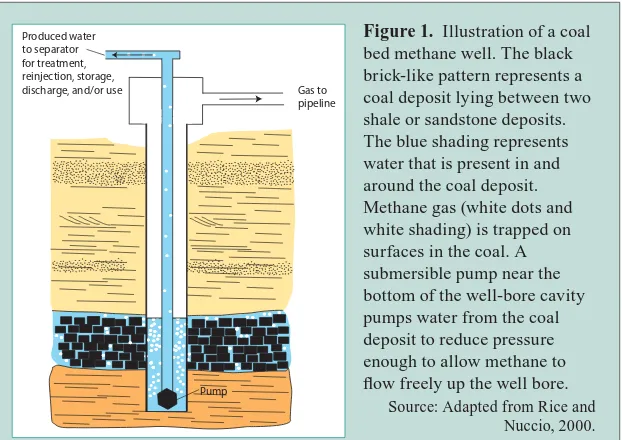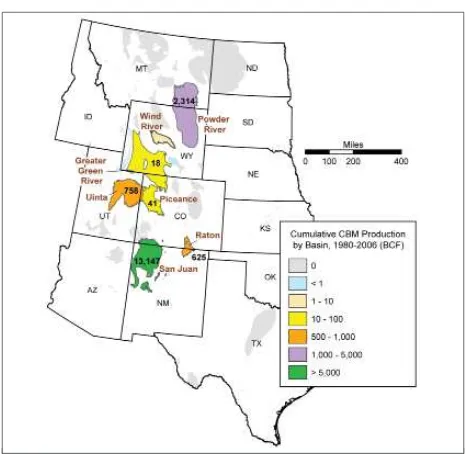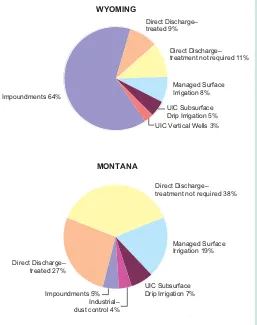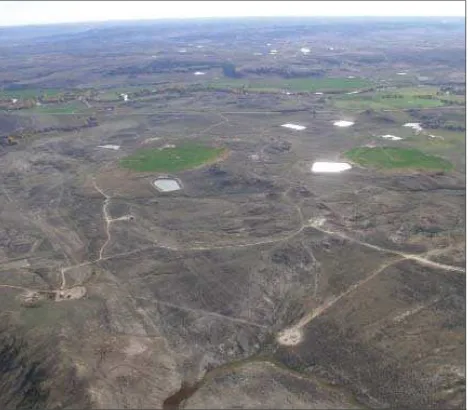M
ethane, an increasingly important energy source, is trapped in some coal beds by water, and sometimes can only be easily extracted by pumping the water to the surface (see Figure 1). Operations to extract methane from coal beds have expanded in the western United States during the past several decades, and in 2008 supplied nearly 10 percent of the total U.S. natural gas production, while producing some 42 billion gallons of water in fi ve western states.Deciding what to do with the water produced from coal bed methane operations,
The extraction of methane (natural gas) trapped deep in some coal beds is a common practice, especially in Western States, but carries with it the issue of what to do with the water that must be pumped out to release the methane. This water must be managed through some combination of disposal, use, or storage, and often requires treatment to manage salts and other compounds. Currently, the majority of the water is disposed of at least cost, rather than being put to benefi cial uses such as for irrigation or drinking water for livestock. This study investigates the critical environmental, economic, and regulatory issues associated with coal bed methane produced water, and fi nds that current management decisions are made within a complex regulatory framework that fails to fully consider opportunities for benefi cial use.
M a n a ge m e n t a n d Effe ct s of Coa l Be d
M e t h a n e Pr odu ce d W a t e r in t h e
W e st e r n Un it e d St a t e s
known as produced water, is a challenging task. The water varies greatly in both quality and quantity, depending on the geology of the coal basin from which it is extracted, and sometimes requires treatment before disposal or use. A complex regulatory framework underlies the management of produced water, with some states’ laws considering the water a waste product of methane extraction, and others considering it a benefi cial byproduct of the extraction process.
At present, the management of coal bed methane produced water is driven by
consider-ation of the costs and complex regulations associated with treating and disposing of produced water, rather than by consideration of potential benefi cial uses. Further-more, there is no national consensus or national regulatory framework on management goals, objec-tives, or policies for coal bed methane produced water. At the request of Congress, the National Research Council convened a committee of experts to review critical Figure 1. Illustration of a coal
bed methane well. The black brick-like pattern represents a coal deposit lying between two shale or sandstone deposits. The blue shading represents water that is present in and around the coal deposit. Methane gas (white dots and white shading) is trapped on surfaces in the coal. A submersible pump near the bottom of the well-bore cavity pumps water from the coal deposit to reduce pressure enough to allow methane to fl ow freely up the well bore.
Source: Adapted from Rice and Nuccio, 2000. Gas to
pipeline Produced water
to separator for treatment, reinjection, storage, discharge, and/or use
environmental, economic, and regulatory issues associated with extracting and managing coal bed methane produced water in the western states of Colorado, Montana, New Mexico, Utah, North Dakota, and Wyoming (see Figure 2).
The Challenge of Coal Bed Methane
Produced Water
Produced water from coal beds contains varying amounts of salts and, in some cases, metals,
depending on the geology and hydrology of the coal beds and surrounding rocks. Both the quality of the produced water and the amount of water that must be removed to allow methane extraction infl uence the way in which produced water is managed. For example, the fairly shallow coal beds in the Powder River Basin of Wyoming and Montana yield large amounts of low-salt content water that can be treated to meet state regulations before being released into local rivers and streams for disposal, or put to benefi cial uses such as irrigation (see Box 1). Some produced water from the Powder River Basin meets water quality standards for disposal or certain uses without any treatment at all. In contrast, the more deeply buried methane-containing coal beds of New Mexico, Utah, and Colorado yield smaller volumes of generally very saline water. Because it would be expensive to treat such relatively small quantities of this water to meet state regulations for surface disposal or use, and because suitable geologic formations are readily available, produced water extracted from coal bed wells outside of the Powder
River Basin is usually reinjected deep into the ground for permanent disposal. Factors such as:
– availability of infrastructure,
– cost of treatment and transport of produced water,
– quality and quantity of produced water, – age of the water in the coal bed and its
connec-tions to other groundwater (see Box 2), and – states’ legal consideration of produced water mean that in certain areas it is easier to dispose of the water at least cost than to pursue benefi cial uses, which may also require treatment.
Environmental Impacts
The short-term environmental effects of the extraction of water from coal beds and its eventual disposal, storage, or use are well-documented, localized, and relatively benign, based on environ-mental monitoring data that are currently available. However, because coal bed methane production is a relatively young industry, further monitoring and analysis of groundwater, surface water, soil, and ecological systems are needed to fully understand the potential for long-term environmental impacts.
To assess potential long-term, pervasive, or regional environmental problems associated with water extracted from coal beds, this report suggests a range of technologies and research approaches, to provide a scientifi c basis for and increase the consis-tency and sophistication of management of coal bed produced water, including:
•
the use of better geochemical fi ngerprinting tools to estimate the age of produced water and to understand the existence and persistence of produced water in surface and groundwater systems (see Box 2);•
increasing the frequency of monitoring before and after production starts to better understand the potential impacts of coal bed methane produced water extraction and management on groundwater, surface water, soil, and ecological systems;•
research on the connections or links between coal bed waters and other groundwater aqui-fers—underground layers of water-bearing rock—and surface water;•
analysis of the effects of extracting non- renewable “fossil” water from coal beds; and•
studies to evaluate the effects of producedwater in indigenous aquatic biological species in the fi eld.
Figure 2. Map of western coal bed methane basins within the six states that are considered in this report.
Studies from the San Juan Basin that used geochemical techniques to “date” coal bed water indicated that the water is thousands to tens of millions years old. These fi ndings suggest that old or “fossil” water in coal beds accumulates slowly, and once removed may not be replenished for many millions to tens of millions of years, making the water essentially a “nonrenewable” resource. However, scientists don’t yet know if all coal beds store water of ancient origins—and more
data are needed to determine the age of produced water from other coal bed basins.
Determining the age of coal bed water and its “renewability” can help in understanding the connections or linkages among coal bed waters, other groundwater aquifers, and surface water. Understanding these connections, in turn, is critical to understanding the consequences of the removal of coal bed waters for local groundwater and surface water systems and how produced water can be appropriately managed.
Box 2. Fossil Water
Box 1. The Options for Coal Bed Methane Produced Water
Many options exist for the disposal, storage or benefi cial use of coal bed produced water. The options employed vary among coal bed basins, among states sharing the same basin, and within basins in the same state (see Figure 3). A summary of these options includes:
Disposal by Reinjection—Produced water can
be reinjected deep underground. This option is often used for the relatively small volumes of very saline water produced from coal bed basins in New Mexico (Raton and San Juan Basins), Colorado (San Juan and Piceance basins), and Utah (Uinta Basin), and generally requires no treatment.
Direct Disposal to Waterways—This
management option often (but not always) involves treating water to meet federal and state water quality standards before discharge to streams and rivers. This option is the primary management approach used for produced water in the Colorado portion of the Raton Basin and is also used in the Powder River Basin.
Storage—Produced water can be stored in
constructed ponds or impoundments. These structures include ponds specially designed to allow the water to evaporate, shallow pits that allow the water to seep into the ground beneath the impoundment, and ponds lined with impermeable materials to prevent leakage into groundwater. This option is the primary approach used in the Wyoming portion of the Powder River Basin.
Potential Use—Produced water could be put to
various uses, including irrigation, drinking water for livestock, industrial applications, wetlands habitat enhancement, groundwater recharge or municipal or domestic purposes. Treatment may be necessary, depending upon initial water quality, to meet different regulatory standards. Currently, benefi cial use applications are only employed for a small proportion of the total volume of coal bed produced water in the West.
Figure 3. These charts illustrate variations in options for the disposal, storage, and use of coal bed methane produced water in Wyoming and Montana.
Source: Adapted from D. Fischer, Presentation to the committee, Denver, CO., March 30, 2009; A. Bobst, Montana Bureau of Mines and Geology, Personal communication, December 21, 2009; T. Reid, Montana Department of Environmental Quality, Personal communication, December 30, 2009; and J. Zupancic, BeneTerra, Inc., Personal communication, December 28, 2009.
Managed Surface Irrigation 19% MONTANA
Impoundments 5%
Direct Discharge– treatment not required 38%
Direct Discharge– treated 27%
UIC Subsurface Drip Irrigation 7% Industrial–
dust control 4% Impoundments 64%
WYOMING
Direct Discharge– treated 9%
Direct Discharge– treatment not required 11%
Managed Surface Irrigation 8%
consideration of the potential benefi cial uses of this resource. Continued research and monitoring to resolve gaps in knowledge of the chemistry and age of the water extracted from coal beds and effects of the water on the environment would permit develop-ment of more effective coal bed methane produced water management practices. More effective prac-tices will help to ensure the stewardship of water resources, particularly in the arid West.
Figure 4. Ponds storing coal bed methane produced water in Wyoming. The green parcels are fi elds irrigated with coal bed methane produced water.
Source: J.W. Bauder
Regulatory Framework
Regulations for leasing and permitting coal bed methane operations on public lands are authorized through the Bureau of Land Management, and those for the protection of surface and groundwater resources are authorized by the U.S. Environmental Protection Agency. Although these federal agencies work in concert with state and tribal authorities to enforce national standards and regulations, the Environmental Protection Agency has delegated responsibility for many permitting and regulatory functions to a number of state agencies and tribes. As a result, many states and tribes oversee the management of produced water in their jurisdiction and have established, through appropriate legal processes, differing standards for the quality of produced water discharged to streams and rivers or used for irrigation or agriculture. In addition, differing state defi nitions of coal bed methane produced water as either a waste product or as a benefi cial byproduct of methane extraction have contributed to differing state approaches to manage-ment of the produced water.
Conclusion
At present, the management of coal bed methane produced water is driven by the costs of water management and regulations regarding the treatment and disposal of produced water, rather than by
Permission granted to reproduce this brief in its entirety with no additions or alterations. Permission for images/fi gures must be obtained from their original source.
© 2010 The National Academy of Sciences
Committee on Management and Effects of Coal Bed Methane Development and Produced Water in the Western United States: William Fisher, (Chair), University of Texas, Austin; James W. Bauder, Montana State University; William H. Clements, Colorado State University; Inez Hua, Purdue University; Ann S. Maest, Stratus Consulting, Boulder, Colorado; Arthur W. Ray, Wiley Environmental Strategies, Columbia, Maryland; W.C. “Rusty” Riese, BP America, Inc.; Donald J. Siegel, Syracuse University; Geoffrey Thyne, University of Wyoming, Laramie; Elizabeth A. Eide (Study Director), National Research Council.
The National Academies appointed the above committee of experts to address the specifi c task requested by Congress. The members volunteered their time for this activity; their report is peer-reviewed and the fi nal product signed off by both the committee members and the National Academies. The members volunteered their time for this activity; their report is peer-reviewed and the fi nal product signed off by both the committee members and the National Academies. This report brief was prepared by the National Research Council based on the committee’s report.



